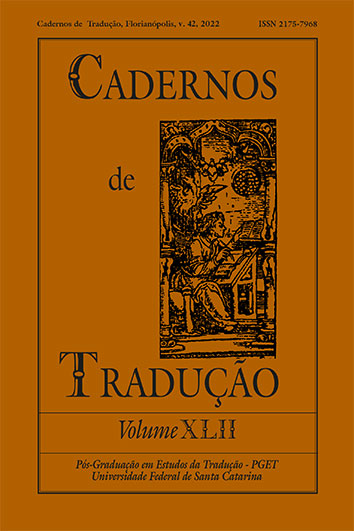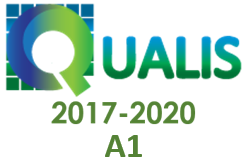The Job Market of Sign Language and Portuguese Translators and Interpreters: a review of recent publications
DOI:
https://doi.org/10.5007/2175-7968.2022.e89768Keywords:
Labor Market, Interpreting, Translation, LibrasAbstract
This article presents a systematic review that identified Brazilian articles, dissertations, and theses that had as their main theme: the labor market of translators and/or interpreters of Libras-Portuguese. The research adopts a quanti-qualitative approach and the data were analyzed based on the Reporting Items for Systematic Reviews and Meta-Analyis (PRISMA) method. The search was conducted using the descriptors “Libras translator”, “Libras translation”, “Libras interpreter” and “Libras interpretation” in four search platforms: Capes, Scielo, Bitra and BDTD. After the adoption of all exclusion criteria, nine papers were selected that address the investigated theme, however, in a tangential and non-specific way. The analysis was performed according to the following criteria: recurrent theme, year of publication, and geographic region of the study. The results indicate the predominance of three themes: career consolidation trajectory, professional profile, and attributions and working conditions. They also indicate that in 2015 there is the largest number of publications and that the studies are concentrated predominantly in the South and Southeast regions. It was concluded that there is a gap in the approach to the theme, which needs to be filled in favor of a better knowledge of the labor market and directions in favor of the training of such professionals.
References
Bardin, L. Análise de conteúdo. Tradução de Luís Antero Reto e Augusto Pinheiro. 4. ed. Lisboa: Lisboa Edições 70, 2007.
Brasil. Decreto 5626, de 22 de dezembro de 2005. Regulamenta a Lei nº 10.436, de 24 de abril de 2002, que dispõe sobre a Língua Brasileira de Sinais - Libras, e o art. 18 da Lei nº 10.098, de 19 de dezembro de 2000. Diário Oficial da União, Poder Executivo, Brasília-DF. 23/09/2010. Seção 1: 28-30.
Brasil. Lei 12.319, de 01 de setembro de 2010. Regulamenta a profissão de Tradutor e Intérprete da Língua Brasileira de Sinais - Libras. Diário Oficial da União, Poder Legislativo, Brasília-DF. 02/09/2010. Seção 1: 1.
Dean, R. K. e Pollard Jr, R. Q. “Application demand-control theory to sign language interpreting: implications for stress and interpreter training”. Journal of Deaf Studies and Deaf Education, 6: 1 (2001): não paginado. Portal da University of Rochester School of Medicine, NY., 17/06/2020. DOI:10.1093/SURDO/6.1.1 Disponível em: https://pdfs.semanticscholar.org/6535/88a7436e1808d118759a45b5caf793890b8e.pdf?_ga=2.244317957.1490731828.1592329942-526624097.1592329942.
Gil, A. C. Métodos e técnicas de pesquisa social. 6. ed. São Paulo: Atlas, 2008.
Gondim, Sônia Maria Guedes. “Perfil profissional e mercado de trabalho: relação com a formação acadêmica pela perspectiva de estudantes universitários”. Estudos da Psicologia, 7. 2. jul./dez. (2002): 299-309. Portal da Universidade Federal do Rio Grande do Norte. 18/10/2021. Disponível em: https://www.redalyc.org/articulo.oa?id=26170211.
Libâneo, José Carlos. Adeus professor, adeus professora? novas exigências educacionais e profissão docente. São Paulo: Cortez, 1998.
Martins, V. R. de O. Posição-Mestre: desdobramentos foucautianos sobre a relação de ensino do intérprete de língua de sinais educacional. 2013. 256 f. Tese (Doutorado em Educação) Universidade Estadual de Campinas, Campinas-SP, 2013.
Martins, V. R de O. e Nascimento, V. “Da formação comunitária à formação universitária (e vice e versa): novo perfil dos tradutores e intérpretes de língua de sinais no contexto brasileiro”. Cadernos de Tradução. 35. 2 jul a dez. (2015): 78-112. Portal de Periódicos da UFSC. 18/10/2021. DOI:10.5007/2175-7968.2015v35nesp2p78. Disponível em: https://www.researchgate.net/publication/285638999_Da_formacao_comunitaria_a_formacao_universitaria_e_vice_e_versa_novo_perfil_dos_tradutores_e_interpretes_de_lingua_de_sinais_no_contexto_brasileiro.
Nogueira, T. C. Intérpretes de Libras-português no contexto de conferência: uma descrição do trabalho em equipe e as formas de apoio na cabine. 2016. 213 f. Dissertação (Mestrado em Estudos da Tradução) Base de Dados da Universidade Federal de Santa Catarina, 2016.
Nóvoa, Antônio. Os professores e a sua formação. Lisboa: Publicações Dom Quixote, 1992. Lisboa.
Pöchhacker, F e Queiroz, M. “Conexões fundamentais: afinidade e convergência nos estudos da interpretação”. Scientia Traductionis, 7 (2010): 61-75. Base de Dados da Universidade de Coimbra. 20/10/2021. Disponível em: https://digitalis.uc.pt/pt-pt/artigo/conex%C3%B5es_fundamentais_afinidade_e_converg%C3%AAncia_nos_estudos_da_interpreta%C3%A7%C3%A3o.
Quadros, Ronice Müller de. O tradutor e intérprete de Língua Brasileira de Sinais e Língua Portuguesa. Brasília: MEC/SEESP, 2004.
Rodrigues, Carlos Henrique e Beer, Hanna. “Os estudos da tradução e da interpretação de línguas de sinais: novo campo disciplinar emergente? Cadernos de Tradução 35 (2015): 17-45. Portal de Periódicos da UFSC. 19/07/2021. DOI:10.5007/2175-7968.2015v35nesp2p17. Disponível em: https://www.researchgate.net/publication/285639160_Os_estudos_da_traducao_e_da_interpretacao_de_linguas_de_sinais_novo_campo_disciplinar_emergente.
Downloads
Published
How to Cite
Issue
Section
License
Copyright (c) 2022 Cadernos de Tradução

This work is licensed under a Creative Commons Attribution 4.0 International License.
Copyright Notice
Authors hold the copyright and grant the journal the right for their articles' first publication, being their works simultaneously licensed under the Creative Commons Attribution License (CC BY), which allows the sharing of such works with its authorship acknowledged and its initial publication in this journal.
Authors are allowed to enter into separate additional contractual arrangements for the non-exclusive distribution of the journal's published version of the work (e.g., post it to an institutional repository or as a book chapter, with an acknowledgment of its initial publication in this journal).








































